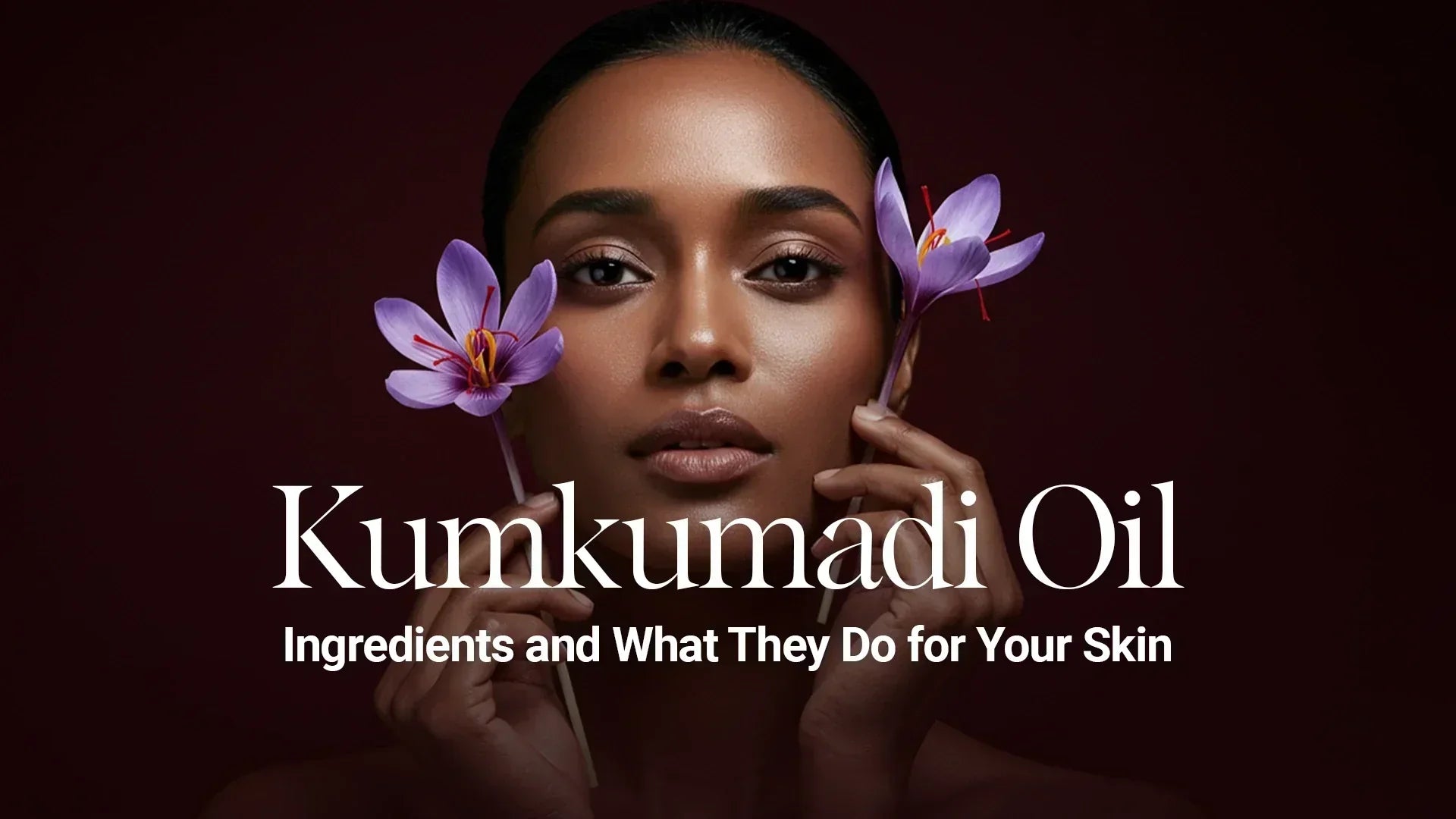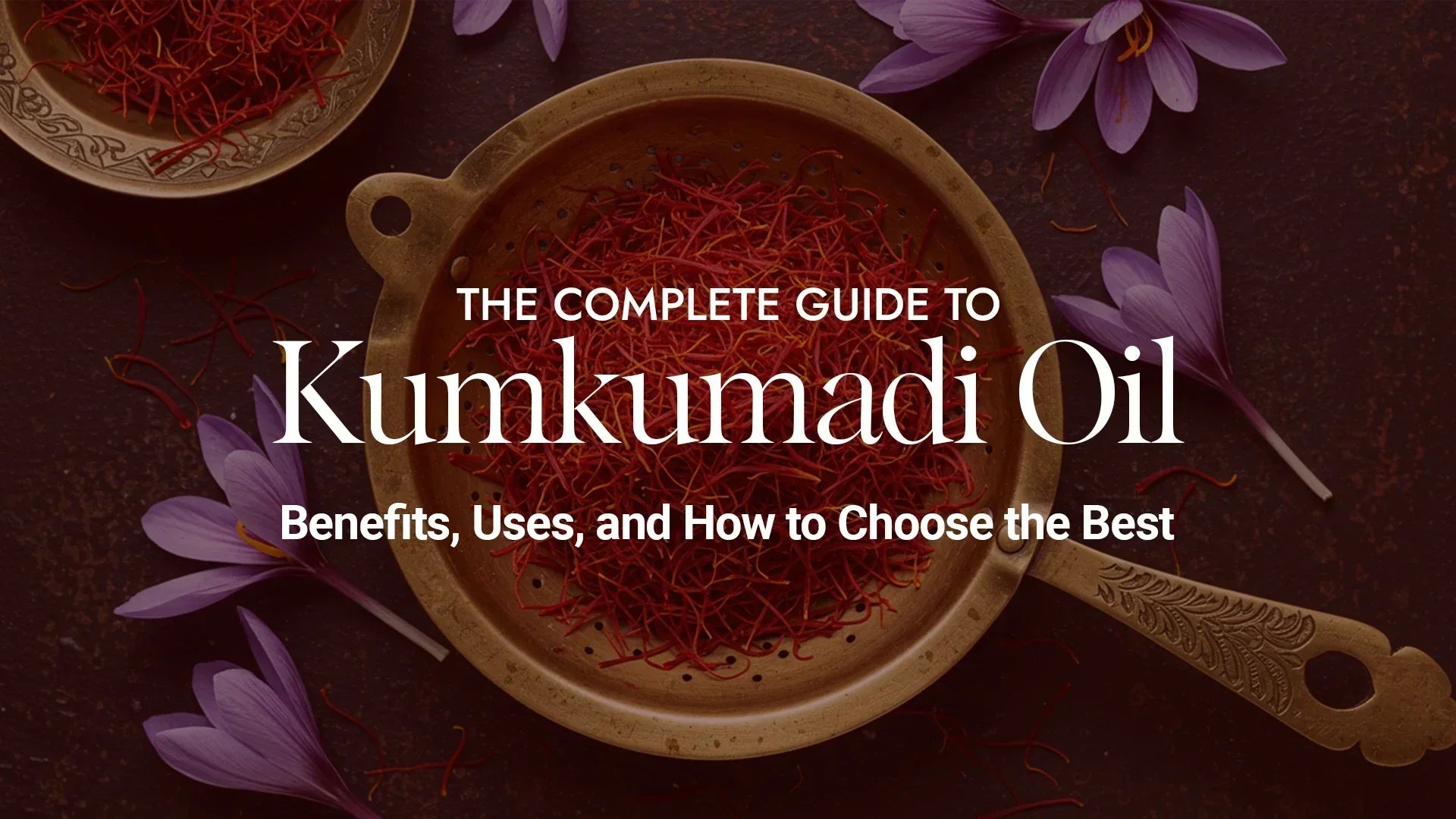Kumkumadi Oil Ingredients and What They Do for Your Skin

For centuries, Indian Ayurveda has provided holistic skin care that not only treats surface issues but also restores inner balance. One of its most cherished formulations is Kumkumadi Tailam, also known as Kumkumadi oil, a golden blend of herbs and oils traditionally used to enhance skin tone, fade marks, and bring out a natural glow.
But here’s the thing: Kumkumadi oil doesn’t work because of one “miracle” ingredient. Its real power lies in how each herb is carefully selected and balanced to support your skin’s tone, texture, healing, and radiance, all rooted in ancient Ayurvedic texts.
Let’s break down what’s inside, and what each ingredient is quietly doing for your skin.
Saffron (Kumkuma)
The star of the show. Saffron, or kumkuma, is what gives the oil its name—and its warm golden tint. Revered in Ayurveda for centuries, saffron is known to:
- Brighten skin
- Improve complexion
- Fade pigmentation and sun spots
Modern studies back this up, too. Saffron contains crocin and safranal, antioxidants that inhibit tyrosinase, the enzyme that produces melanin. This means it gently reduces uneven skin tone over time and boosts your skin’s natural radiance.
Manjistha (Indian Madder)
A classic Ayurvedic herb used for blood purification, manjistha is known for its skin-healing potential. It’s particularly effective at calming inflammation, detoxifying skin tissue, and supporting long-term skin clarity.
If you deal with stubborn post-acne marks or sensitivity, this herb works gently but persistently to fade blemishes and improve circulation. Regular use helps your skin appear more even-toned, less congested, and visibly healthier.
Licorice Root (Yashtimadhu)
Licorice may not sound as exotic as saffron, but it plays a major role in skin-brightening and calming irritation. The root contains glabridin, a compound that helps fade dark spots by controlling melanin transfer within skin cells.
It’s also incredibly helpful for skin that tends to get red or reactive. For those managing sun spots or acne-related pigmentation, licorice supports gentle brightening without the sting of acids or harsh lighteners.
Turmeric (Haldi) Powder
Used in Ayurveda for a wide range of applications, from wound healing to skincare, turmeric is a powerful ingredient. It contains curcumin, which is known for its anti-inflammatory and antioxidant properties. In Kumkumadi oil, turmeric helps reduce redness, calm breakouts, and even out skin tone.
It's especially beneficial for skin prone to dullness or occasional flare-ups, as it adds a layer of natural protection and glow without being harsh or drying.
Sandalwood (Chandan)
Used for centuries in Indian rituals and remedies, sandalwood brings a soothing, cooling effect to the mix. Kumkumadi oil helps reduce irritation, refine pores, and smooth out skin texture.
It also has antimicrobial properties, making it especially valuable for acne-prone skin. Sandalwood balances the more active ingredients in the formula, ensuring the oil remains nourishing and gentle even with daily use.
Sesame Oil (Til Taila)
A cornerstone in Ayurvedic oil formulations, sesame oil is both nourishing and functional. Light, fast-absorbing, and naturally antibacterial, it forms the base of many classical tailams.
In Kumkumadi oil, it acts as the carrier for all the herbal actives. It penetrates deep into the skin layers, delivering nutrients while keeping the skin soft, balanced, and protected.
Almond Oil (Badam Taila)
Used as part of the base, almond oil deeply moisturises the skin and supports elasticity. It’s rich in vitamin E, which helps protect against oxidative stress and environmental damage.
What makes almond oil ideal for a formula like Kumkumadi tailam is that it delivers softness and hydration without clogging pores. It also enhances the penetration of herbal extracts, helping them work more effectively.
Orange Peel Powder
A natural source of vitamin C, orange peel powder supports skin brightening and gentle exfoliation. It helps remove dead skin cells, boosts radiance, and tightens the appearance of pores. Combined with herbs like saffron and turmeric, it enhances the oil’s ability to refresh dull, tired skin.
Despite being fruit-derived, it's mild and soothing when infused in oil, making it safe even for sensitive skin.
Why the Blend Matters
Each ingredient in Kumkumadi oil plays a specific role, but it’s the combination that makes the formula so powerful. This isn’t just a face oil that moisturises. It:
- Brightens skin tone
- Fades pigmentation and acne scars
- Calms inflammation and redness
- Hydrates without heaviness
- Protects against oxidative damage
What’s Not Included (But Should Be Noted)
High-quality, clean Kumkumadi oils avoid:
- Synthetic fragrances (which can irritate sensitive skin)
- Parabens or sulphates
- Artificial colourants
- Non-vegan ingredients like goat’s milk
For example, Hue & Shades’ Kumkumadi Oil is 100% vegan, free from toxins, and formulated without any animal-derived ingredients, making it suitable even for sensitive or ethical skincare users.
Final Thoughts
Kumkumadi oil’s effectiveness lies not in a single superstar herb, but in the harmony of its ingredients. When prepared traditionally and used consistently, it delivers real, noticeable changes in tone, clarity, and texture.
Understanding what’s inside your bottle helps you use it more effectively and enables you to spot the genuine product in a market full of watered-down imitations.
Want to explore everything Kumkumadi oil can do for your skin? Our complete guide to Kumkumadi oil covers usage, skin types, and how to choose the best one.




